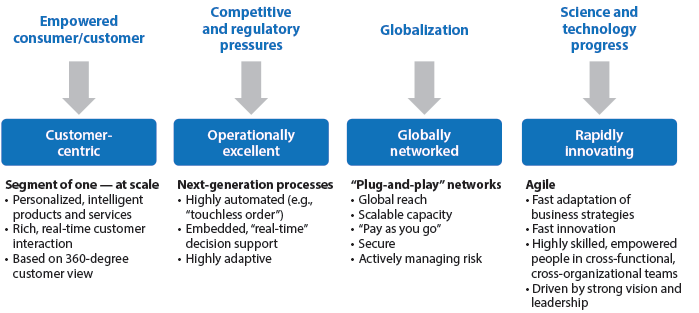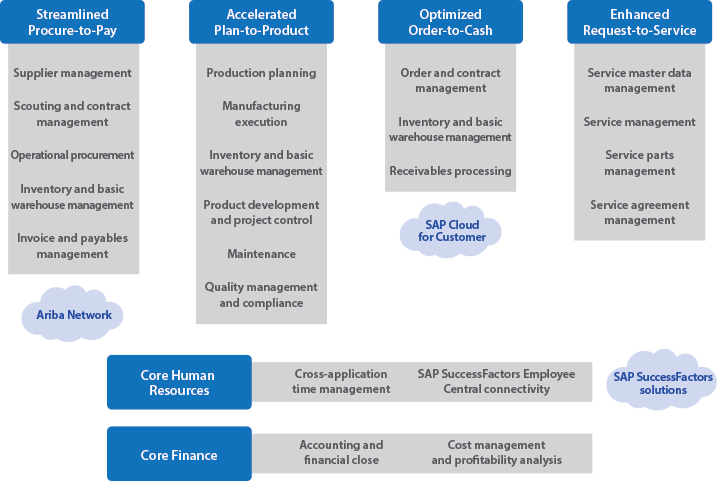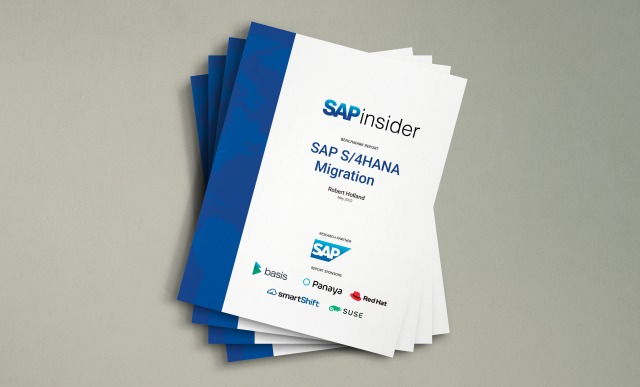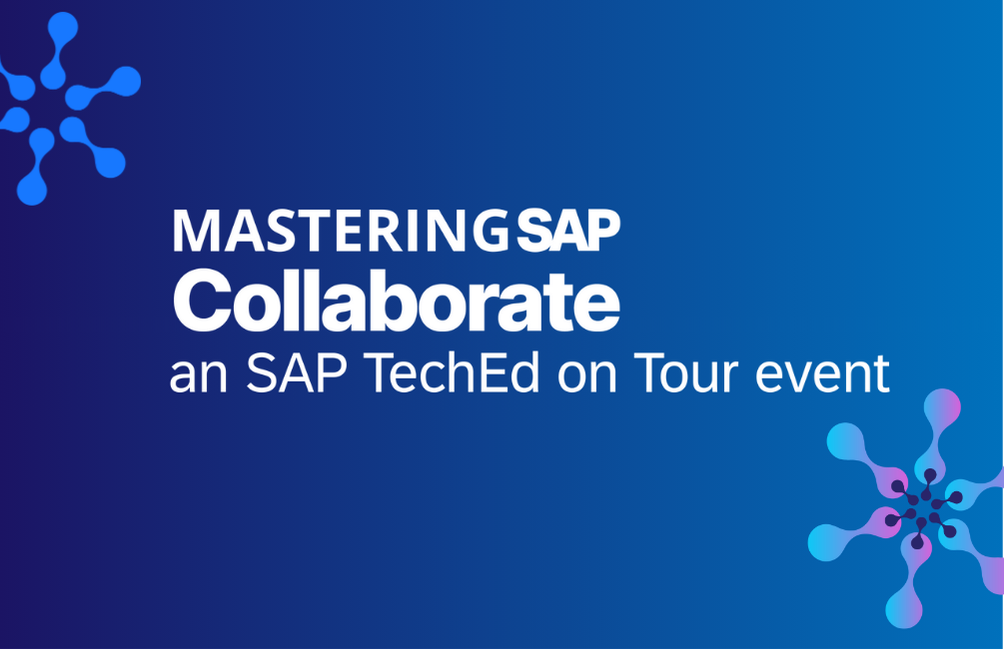Spark Business Transformation with a Digital Core
Reimagining Business Processes with the Newly Released SAP S/4HANA Enterprise Management
The enterprise today must be prepared to seize a business opportunity the moment it comes into view. This opportunity could present itself in the form of a company making an acquisition or divestiture, competing for new business, or even exploring a new revenue stream by creating a new business model. In a fast-moving digital economy, the window to capture these opportunities closes quickly; the company that is unprepared to pounce when occasions arise will likely get stuck on the road to irrelevance. Organizations need to be willing to change: They have to assess whether they are truly in a position to reinvent business processes every day — not just every generation.
This need for an unprecedented level of business agility to match the rapid pace of innovation and transformation present in business is not restricted to a particular industry. Rather, we see entire markets, including transportation, logistics, and ecommerce, being reinvented on a seemingly daily basis. For any industry in which the production, shipment, and transaction of a product is still relevant, transformation supported by digitization is fast becoming a necessity (see Figure 1).
Explore related questions

Digitization of the business is also important in the context of the growing influence that the millennial generation has on the workplace. Anyone who comes of age in the beginning of the 21st century expects constant connectivity. Millennials are far less inclined to limit business to traditional business hours. Work is not a place, but rather an activity that can be undertaken anywhere, at any time. Similarly, the concept of “work” as putting in time at a 9-to-5 career has evolved; younger workers are willing to trade stability for independence in a shift toward more contract jobs, and employers are responding in kind as more than 80% of all managers are expected to hire contingent workers over the next three years. To manage this flexible, dynamic ecosystem of talent, the enterprise needs to enable next-generation digital business processes that remain effective even when distributed in non-traditional formats.
Rise to the Occasion with Newfound Flexibility
Pressures to reshape the business using a digital template are likewise common across the industry spectrum. Companies — both in the business-to-business (B2B) and business-to-consumer (B2C) worlds — expect personalized interactions as a “segment of one,” which necessitates individualization of products and services, and freedom of choice. The business has no choice but to meet these demands — on the platform the customer chooses — or risk customers going to a competitor.
There is also a growing need for enterprise transparency to comply with rising compliance and regulatory pressures. This means that companies need to attain operational excellence to stay ahead of competitors that wish to exploit this transparency for their own gain. Additional pressures include an increasing need to become a global enterprise to stay relevant, as well as the quickening pace of technology progress that often require developing new strategies to cope.
The common solution that addresses all of these pressures is agility, and the way to achieve that agility is with a flexible, digital core at the heart of every organization that can meet the demands presented by increasing across-the-board disruption. With a digital core, organizations can do far more than simply meet these pressures at a minimum base level of success. They can pivot in near real time to capitalize on innovations in areas such as cloud, big data, and business network connectivity to completely transform the business, whether it’s to keep up with the growing influence of emerging topics such as the Internet of Things (IoT), 3D printing, or augmented reality, or to defend against new competitors launching up all around them.
SAP S/4HANA Enterprise Management builds on the success of SAP Business Suite powered by SAP HANA with a completely new and reimagined suite that is the industry’s first digital core.
5 Pillars of a Digital Core
A digital core is an enabling platform for transformation and innovation, but what are its hallmarks? We find five key characteristics that make up a digital core:
- A digital core provides the enterprise with the capability to drive and anticipate business outcomes in real time.
- It integrates the business seamlessly across all value chain processes such as client interaction, administration, production, and research and development.
- A digital core increases efficiency by automating processes and distributing responsibility for customer insights across an intelligent business network.
- It increases effectiveness by converting signals in business data into tangible action, essentially bringing big data to the size and scale needed to turn insight into action for the everyday user.
- A digital core increases enterprise agility by elevating each employee’s view of the organization.
Companies can achieve these levels of efficiency, effectiveness, and agility and drive end-to-end digitized operations across key business functions with the newest innovations in SAP S/4HANA Enterprise Management, the latest release of SAP S/4HANA, which includes the 1511 update. This major milestone delivers a massive wave of simplifications and innovation in the digital core that covers mission-critical business processes across lines of business, including finance, sales, service, marketing, commerce, procurement and sourcing, manufacturing, supply chain, and human resources. SAP S/4HANA Enterprise Management builds on the success of SAP Business Suite powered by SAP HANA with a completely new and reimagined suite that is the industry’s first digital core.
A Reimagined Core for Reimagined Processes
Before looking at a specific use case for how a line of business can leverage a digital core in transformative ways, let’s take a moment to examine what the simplifications and innovations in SAP S/4HANA Enterprise Management include (see Figure 2).

For starters, the solution covers all core business processes, such as order-to-cash and procure-to-pay, as well as core capabilities such as finance and a variety of specialized line-of-business and industry capabilities. In addition, it delivers native integration with SAP’s cloud-based technology such as SAP SuccessFactors solutions and the Ariba Network.
By leveraging these innovations, an enterprise can drive unprecedented business value, for example, in the following ways:
- Optimizing working capital with new accounts payable and accounts receivable cockpits
- Decreasing stock buffers with a simplified data model in inventory management for real-time, high-volume processing
- Increasing visibility with real-time stock and material flow insight
- Lowering procurement costs with standard integration to the Ariba Network
- Improving customer service with a new sales order fulfillment cockpit for instantly identifying bottlenecks and issues
What this means from the perspective of day-to-day operations is that formerly siloed lines of business now have complete visibility into the entire core business of the enterprise. Finance, sales, and manufacturing can now act in concert, basing decisions on the same information in real time. A perfect example is showcased in SAP Digital Boardroom, a product based on the capabilities of the digital core. It demonstrates what you can do in a real-time state of business — and with SAP S/4HANA of course you can do this beyond the boardroom as well.
Out with the Old
To see how this translates to specific business processes, let’s take a closer look at one of our use cases, real-time inventory management. The traditional challenge in inventory management is to provide precisely the right amount of product to the right customer at precisely the right time. While this has been possible with classic and longstanding inventory management processes, it has not been without its struggles. Those processes also have traditionally entailed manual workarounds, costly overstocks and safety stocks, and significant fire drills to accommodate last-minute changes.
However, with the need to adopt a “segment of one” mindset to accommodate evolving customer expectations, which include an expectation for immediacy, those processes have reached their functional limitations. Classic inventory planning simply cannot keep up with those flexible accommodations or the custom configurations that customers have come to expect.
As new orders fly in at a high rate, traditionally slow update cycles lead to outdated information. Limited inventory visibility increases error rates, and leads to supply shortages which in turn affect available-to-promise levels and, finally, unacceptable customer churn.
In with the New
So what does real-time inventory management look like with a digital core powered by SAP S/4HANA Enterprise Management? In a nutshell, a digital core enables real-time processing of inventory postings and inventory values so that warehouse inventories are always in harmony with demand and supply. Real-time visibility extends to using company-wide data analysis to influence key decisions about stock levels, rather than needlessly reserving warehouse space while waiting to make decisions based on overnight data loads. We close the gap between the digital and the physical reality.
SAP S/4HANA Enterprise Management is a monumental milestone, but arriving at a digital core is not as difficult as it may seem.
Real-time inventory management extends beyond warehouse management to take all product locations and external supply chains into account, thus managing changing demand at an unprecedented level of granularity. Organizations can begin to manage inventory in a completely need-based way. Benefits include customers receiving a product of their choice even with a last-minute change to the order, because at this granular level a single item can be posted in the system the same second it is removed from the warehouse and used to fulfill an order. With a lot size of one matching the customer segment of one, there is no more manufacturing offset between what is happening physically on the shop floor and what’s happening in IT.
A New Solution for a New Philosophy
The SAP S/4HANA Enterprise Management digital core creates this value because its new architecture — optimized for the in-memory platform SAP HANA — turns on its head the prevailing philosophy of how inventory management should be run. The old philosophy held that to ensure maximum performance, data should be stored directly in the application itself. The problem was that with mission-critical processes such as inventory management, multiple applications often leverage the same information while requiring different levels of detail. This, of course, led to redundancies and needless complexity when trying to manage consistency between multiple aggregate tables and sourced data.
Conversely, SAP S/4HANA Enterprise Management can handle this newfound granularity in inventory management because the application master data can be flexibly extended by additional stock times without having to define new and redundant stock tables. With the new data model, everything exists in one place and there is no more separation of entities in different tables.
The Race to Digitization Is On
We’ve used inventory management here as a common example familiar to most any organization that produces a product or provides a service, but with SAP S/4HANA Enterprise Management bringing together core processes for 10 lines of business in one central system, it is certainly not the only use case. More than 2,000 customers have already started to explore transforming their businesses with SAP S/4HANA, and they’ve started restructuring processes to spark transformation and innovation in areas such as material requirement planning, sales order fulfillment, on-demand soft financial close, and real-time fraud detection.
Until only recently, most of the clients I spoke with were questioning the need for digitizing the enterprise. Now they want to know the most efficient route to get there. And while SAP S/4HANA Enterprise Management is certainly a monumental milestone, clients are surprised to discover that arriving at a digital core is not as difficult as it might seem for making this amount of transformation possible. It does not entail, as many suspect, a multi-year upgrade. With SAP Activate, we have a dedicated implementation methodology to help customers move to SAP S/4HANA with ready-to-run, digitized business and technology processes as well as guided configurations to support multiple starting points, including new implementations, system conversions, and landscape transformation.
A digital core helps any business run faster and simpler, so getting there should not be as complex and complicated as the siloed line-of-business applications and redundancies a business is leaving behind. For more information, visit www.sap.com/s4hana and www.sap.com/activate.








